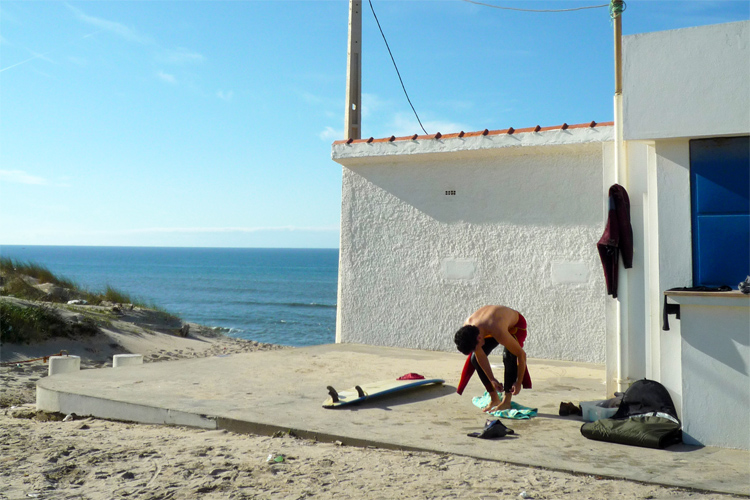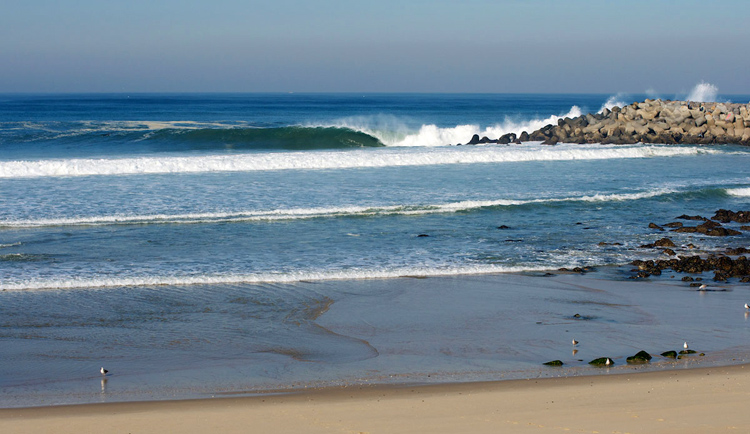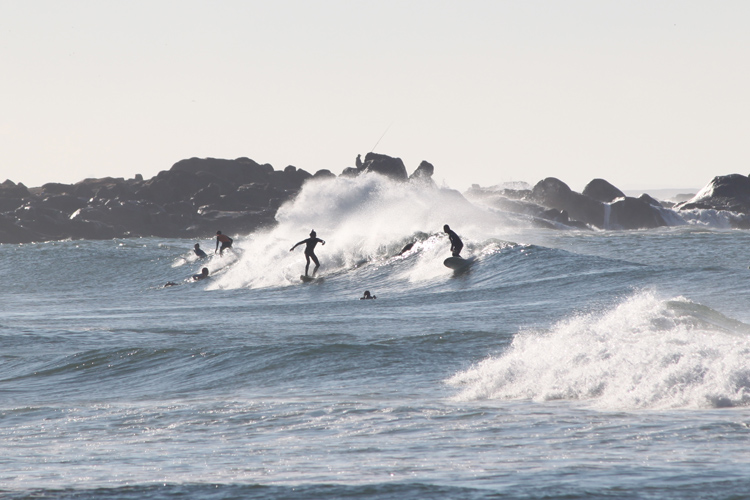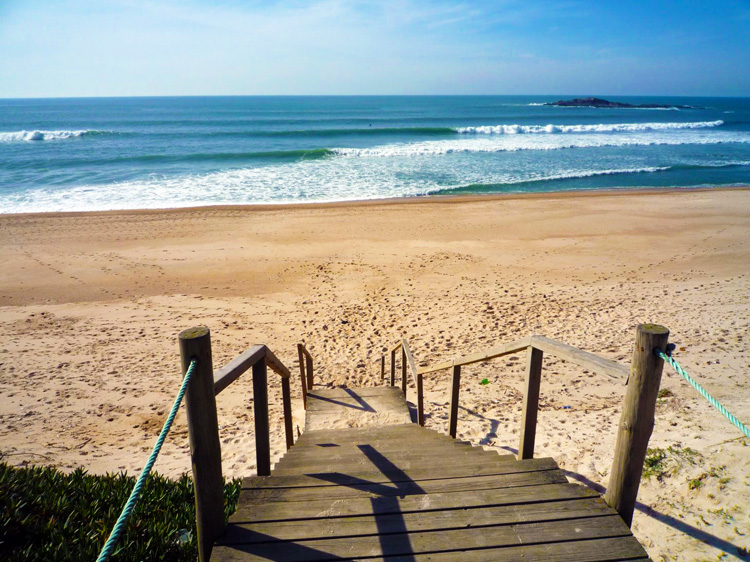Portugal has roughly 1,115 miles (1,794 kilometers) of coastline. It is considered one of the greatest surfing destinations on the planet. However, the eyes of the world are always focused on the same spots.
And you know them already. That's why it's time to unveil Portugal's charming "ugly duckling."
Ericeira, the surfing capital of Europe. Peniche, Europe's most famous barreling wave.
Nazaré, the biggest wave in the world. The Azores, the surfing jewel of the Atlantic. And that's it.
You've heard it multiple times: "Portugal is an amazing surfing country." Sure.
But the truth is that foreigners never get the whole picture. Not even one-tenth of what Portugal has to offer.
In mainland Portugal, all they hear and get is the stretch of coast between Nazaré's Praia do Norte and Lisbon's Costa de Caparica. And that's 90 miles (145 kilometers) of dreams promoted to exhaustion.
But is there anything else to ride? Are there any hidden peaks left to explore? The answer is excitingly positive.
In the past two decades, the number of European surf travelers who decided to explore alternatives to Ribeira d'Ilhas and Supertubos has substantially increased.
Portugal's Southwest Coast ("Costa Vicentina") is a natural paradise. It is also the longest stretch of protected coast the country has to offer.
There are hundreds of magnificent surf spots surrounded by impressive cliffs and breathtaking landscapes.
Surf vans are constantly traveling up and down the coast in search of the best swell angles.
The Forgotten Coast
However, Portugal's "ugly duckling" is located far away from this warm and sunny heaven.
It's the forgotten coast - the rugged and rough shoreline found up in the north.
Nobody talks about it; nobody cares except for the massive community of Northern surfers that live and breathe surf in the region.
"We don't exist for surf magazines and surf brands. But we live pretty much okay with that," explains an unidentified 38-year-old surfer from Porto, the northern city that gave its name to Portugal.
"The truth is that we end up being as good in surfing as those who live near the 'dream spots' that make it to the news."
"Our training conditions are opposite of those in the Central Coast and Lisbon area."
"They have perfect peeling right and left-handers. We have randomly breaking waves; their rollers break like in artificial wave pools; we surf closeouts on a daily basis."
Portugal's Northern Coast is quite different from the surf postcards promoted by the national tourism board and later shared by international magazines.
But it doesn't mean it shouldn't be discovered.
It is rather amazing. A bit like discovering surfing in Ireland and Scotland.

Cold Waters and Uncrowded Gems
Surprisingly, or maybe not, the Northern Coast has probably as many surfers as the most hyped breaks in the central region and Lisbon area.
And it doesn't matter if the thermometer indicates 41° F (5° C).
They're always out there in their 4/3 and 5/4 wetsuits, battling the prevailing northwesterly winds and swells.
"It does get onshore a lot of the time. But we don't see it as a problem. You'll notice how we learned to take off and pop up quickly," adds the veteran surfer from Porto.
"And because waves tend to be fast and unpredictable, we have been forced to read the wave and make decisions in a matter of milliseconds."
Generally speaking, the surf industry doesn't believe in the potential of the Northern Portuguese surfers.
But then again, it hasn't stopped them from winning national and international titles in surfing competitions, but in the bodyboarding scene as well.
And the irony of all ironies is that the oldest European surf film was shot between 1926 and 1927 in Leça da Palmeira, a fishing town on the outskirts of Porto.
The documentary features a group of men riding white water waves with their homemade bellyboards.
Only a few years after Duke Kahanamoku introduced surfing in Australia.
Portugal's Northern Coast starts near the Spanish border in Moledo and ends 70 miles (113 kilometers) down south in Espinho.
You can connect both towns by driving along the coastal highway (A28) in less than 75 minutes.
And there are so many hidden surf gems along the way.
Desert beaches, uncrowded reef breaks, sunset paradises, untouched point breaks, and heavy waters, too.

Windy, Cold, and Idyllic
The starting point is Moledo and Vila Praia de Ancora. Both spots offer wide-open beaches with multiple wave peaks for all levels of surfing experience.
A little down south, you'll find Praia da Arda, a popular spot that has been surfed for nearly five decades.
The wind is a constant variable at Cabedelo, an iconic windsurfing spot located near Viana do Castelo.
But with favorable trades, it can get perfect from a surfer's perspective.
Our journey continues, and we stop at Ofir to ride the multiple breaks on offer north and south of the jetty.
A few kilometers down the coast, a golf course keeps the coastline free from buildings.
A couple of spots stand out for their endless opportunities - Aguçadoura and Estela.
On weekends, they attract dozens of passionate surfers traveling from distant inland cities.
Despite the cold water, you might find your inner self (and the meaning of life) in these empty stretches of white sand.
After crossing the laid-back town of Vila do Conde, you'll enter Azurara, one of the most popular surf spots in the North of Portugal.
Despite the always-present surf schools, there are waves for everyone in a relatively chilled-out surfing environment.
Mindelo, on our travel down to Porto, is a temperamental surf spot.
The first surfers discovered it in the 1980s, and since then, it has also become bodyboarding heaven.
On the best surfing days, with the low tide, it will resemble Bells Beach. As the tide comes in, experienced boogie boarders descend upon the beach to ride the barreling waves and pull the craziest airs.
Leça da Palmeira is one of the most important breaks on Portugal's Northern Coast.
It has built a solid surfing community and reputation, with hardcore chargers and charismatic personalities.
The spot is extremely exposed to powerful winters and the Atlantic's full-force swells, but the locals are always ready for the hardest challenges.

Porto: 300 days of Surfing Per Year
As you cross Portugal's second-largest artificial seaport - Porto de Leixoes - you enter the country's one and only surf city.
Porto and Matosinhos share a large urban beach that offers more than 300 days of surfing per year.
Porto-Matosinhos is the only Portuguese beach that is accessible by subway.
And with thousands of visiting European students on exchange programs, the spot is truly an international surf nation.
You'll hear English, German, Spanish, French, and Scandinavian languages as you paddle for the incoming wave.
On a Saturday morning, you'll easily count more than 500 surfers in the wide lineup.
Our journey ends in the city of Espinho. On a good day, there are surprises waiting for you.
Because when the barreling machine is on, you'll experience one of the classiest tube peaks Portugal has to offer.
Portuguese beaches ought to be considered national treasures. They are precious and sensitive.
And if surfing is the new golf, the government and local authorities should ensure their natural coastal gems are cleaned all year round, and not only when tourists visit the country for their summer holidays.
